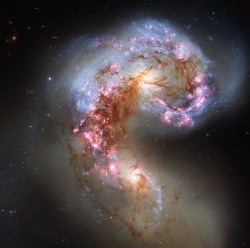An international team of astronomers has obtained the best view yet of two galaxies colliding when the universe was only half its current age.
The team relied heavily on space- and ground-based telescopes, including the Hubble Space Telescope, the Atacama Large Millimeter/submillimeter Array (ALMA), the Keck Observatory, and the Karl Jansky Very Large Array (VLA). But the greatest asset was a chance cosmic alignment.
“While astronomers are often limited by the power of their telescopes, in some cases our ability to see detail is hugely boosted by natural lenses created by the universe,” said lead author Hugo Messias of the Universidad de Concepción in Chile and the Centro de Astronomia e Astrofísica da Universidade de Lisboa in Portugal.
Such a rare cosmic alignment plays visual tricks, where the intervening lens (be it a galaxy or a galaxy cluster) appears to bend and even magnify the distant light. This effect, called gravitational lensing, allows astronomers to study objects which would not be visible otherwise and to directly compare local galaxies with much more remote galaxies, seen when the universe was significantly younger.
The distant object in question, dubbed H-ATLAS J142935.3-002836, was originally spotted in the Herschel Astrophysical Terahertz Large Area Survey (H-ATLAS). Although very faint in visible light pictures, it is among the brightest gravitationally lensed objects in the far-infrared regime found so far.
The Hubble and Keck images reveal that the foreground galaxy is a spiral galaxy, seen edge-on. Although the galaxy’s large dust clouds obscure part of the background light, both ALMA and VLA can observe the sky at longer wavelengths, which are unaffected by dust.
Using the combined data, the team discovered that the background system was actually an ongoing collision between two galaxies.

First, the team noticed that these two galaxies resembled a much closer system: the Antennae galaxies, two galaxies that have spent the past few hundred million years in a whirling embrace as they merge together. The similarity suggested a collision, but ALMA — with its high sensitivity and spatial resolution — was able to verify it.
ALMA has the unique ability to detect the emission from carbon monoxide, as opposed to other telescopes, which might only be able to probe the absorption along the line of sight. This allowed astronomers to measure the velocity of the gas in the more distant object. With this information, they were able to show that the lensed galaxy is indeed an ongoing galactic collision.
Such collisions naturally enhance star formation. Any gas within the galaxies will feel a headwind, much as a runner feels a wind even on the stillest day, and become compressed enough to spark star formation. Sure enough, ALMA shows that the two galaxies are forming hundreds of new stars each year.
“ALMA enabled us to solve this conundrum because it gives us information about the velocity of the gas in the galaxies, which makes it possible to disentangle the various components, revealing the classic signature of a galaxy merger,” said ESO’s Director of Science and coauthor of the new study, Rob Ivison. “This beautiful study catches a galaxy merger red handed as it triggers an extreme starburst.”
The findings have been published in the Aug. 26 issue of Astronomy & Astrophysics and is available online.

